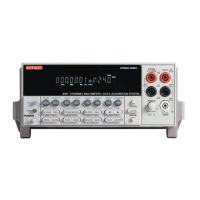4-16 Range, Digits, Rate, Bandwidth, and Filter Model 2701 User’s Manual
If the noise does not exceed the selected window, the reading is based on the average of
the reading conversions. If the noise does exceed the selected window, the reading is a
single reading conversion and new averaging starts from this point. The noise window for
the two filter types are compared in Figure 4-3.
The five window selections from the front panel are 0.01%, 0.1%, 1%, 10%, and NONE
(no window). For remote programming, the window can be set to any value from 0.01% to
10% or NONE.
For voltage, current, and resistance, the filter window is expressed as a percent of range.
For example, on the 10V range, a 10% window means that the filter window is ±1V.
For temperature, the filter window is expressed as a percent of the maximum temperature
reading. The maximum temperature depends on which thermocouple is being used. For
example, for a Type J thermocouple, the maximum reading is 760°C; a 10% window
means that the filter window is ±76°C. For temperatures below 0°C, the overflow point is
-200ºC, so a 10% filter window is ±20ºC. If using ºF units, a 20% filter window is
calculated as follows: 9/5 x 20 = 36. The filter window for the 20% window is ±36ºC.
Filter example
Filter Type - Moving
Filter Window = 0.01% of range
Filter Count = 10
Filter State = On
Ten readings fill the stack to yield a filtered reading. Now assume the next reading (which
is the 11
th
) is outside the window. A reading will be processed (displayed); however, the
stack will be loaded with that same reading. Each subsequent valid reading will then
displace one of the loaded readings in the stack. The FILT annunciator will flash until 10
new readings fill the stack.
NOTE Bit 8 of the Operation Event Status Register sets when the filter window has
properly settled (or the filter is disabled). See Section 11, “Status Structure,” for
details.

